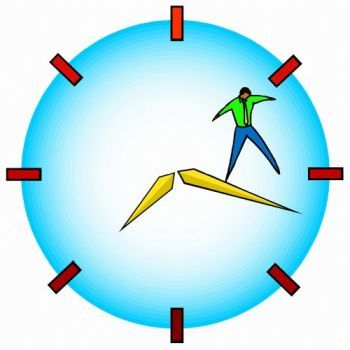The news cycle is a term we hear a lot of. It may evoke in us the exciting rush of 24/7 news-on-demand or arouse stressful feelings of information overload. For some, it recalls memories of simpler times, when the news cycle consisted of perusing the paper over breakfast, catching a mid-day radio update and tuning in to the nightly news before turning in.
“News cycle” might elicit all of the above.
The problem is that this term means different things to different people. The differences aren’t contradictory, but because the “news cycle” is often used so casually, the confusion is understandable. It’s difficult to sort through broadcast, print and online media for news that’s relevant, informative, proportionate and engaging. This misunderstood term fuels those feelings of “Stop the news cycle, I want to get off.”
But when we unravel the definition, we’ll see that we can actually master the news cycle, improve our news habits, and become better informed.
This article is part of a series on news literacy educating readers how to better judge news reports.
Join the fight for Israel’s fair coverage in the news
News Cycle: The Simple Definition
Boiled down to its essence, the simplest understanding is expressed by the Oxford Reference definition (emphasis added):
The period of time that elapses before one news story or batch of stories is replaced by another.
The confusion stems from three general ways to understand what is meant by “replacing” the stories. In short, “replacement” can be the the result of:
- Standard work flow of journalists.
- The ebb and flow of the stories in the news.
- People trying to manipulate coverage.
I’ll briefly expand on these three approaches and add a fourth, reader-centric approach that allows us to take back the news cycle.
Related reading: 3 Tips to Avoid News Burnout
1. Relative to the Journalists
Traditional old-school journalism measures the news cycle relative to individual news services.
The print edition of your local daily newspaper operates on a daily news cycle. If your local TV station broadcasts news shows in the morning, afternoon and evening, its news cycle operates on several hours. Radio stations featuring news bulletins at the top of the hour work on a hourly news cycle, while weekly magazines operate on a weekly news cycle.
Today, editors can publish news online at any time. Real-time news is available when journalists opt to cover news in a live-blog format or post developments on social media.
Instant news.
Any time.
This is what has come to be known as the 24/7 news cycle.
Related reading: News Literacy: Why Headlines Matter
2. Relative to the Stories
Sometimes, the term news cycle is used in relation a story itself and where it is in the pattern of its own rise and fall from public interest.
Stories with a higher profile, especially if they are taking place over a period of time or attracting more than a passing public interest have a longer news cycle. Examples might include a prominent trial lasting several days, various political developments, a visiting world leader, or a notable scientific breakthrough. The general arc of coverage includes the first initial breaking reports, what the players are doing in response, what people are saying, and then, as the story declines, some followup.
Some stories are said to “have legs,” meaning, they will be in the news for a long time. Political scandals are the best example.
Related reading: The Purpose of Journalism: What Do We Need It For?
3. Relative to Manipulation
Have you ever wondered why bad news is often released late in the day — or on weekends? Or why some organizations are more successful at getting their press releases into the news? Or how some journalists are able to quickly digest and sum up complicated studies released by various organizations?
That’s all because the public relations industry understands the nature of journalists’ work habits and how coverage of developing stories is likely to play out. So if you’re trying to attract (or deflect) attention, you’ll need to influence the news cycle. No matter how on-point your message is, timing matters.
Here are some examples of the news cycle as viewed through the lens of P.R.
- Press releases: Because of the 24/7 news cycle, press releases can be easy go-to material for an editor looking for filler content. But no matter how relevant, compelling or informative the press release, it can easily get lost in the mix of dozens of others, so knowing the best and worst days of the day or week to send a press release is part of the news cycle from a P.R. point of view.
- The Friday news dump: Bad news is often deliberately released late in the day — after journalists have gone home — to soften the p.r. hit. Other disclosures are routinely released in what journalists refer to as the Friday news dump. That’s when government officials, political candidates and corporate executives and others might release information they hope will fly below the public radar such as disappointing policy assessments or earnings reports for example.
- The embargoed press release: This is a press release shared with reporters ahead of a clearly-stated release date on condition they don’t report their stories ahead of that time. There are valid reasons for this practice, including giving reporters time to prepare complex stories ahead of time. However, some journalists can’t necessarily be trusted to observe the embargo, and some organizations may time the release of a report to upstage someone else.
- News overshadowing you: Depending on how you’re trying to influence the news, you have to be aware that breaking developments can eclipse your efforts.
There’s a lot value to what public relations does in the world. P.R. is keenly attuned to the news cycle, but in a different way than editors and newsmakers.
Related reading: The 7 News Habits You Need to Develop
4. The News Cycle is Relative to You!
 You don’t have to be an editor, a newsmaker or a P.R. executive to have a news cycle. Your interests, your needs, what you find engaging is all that matters. Where and when you get your news is in your hands.
You don’t have to be an editor, a newsmaker or a P.R. executive to have a news cycle. Your interests, your needs, what you find engaging is all that matters. Where and when you get your news is in your hands.
You can create your own news cycle.
You think you don’t matter? Think again.
Media services and advertisers spend trainloads of money studying what holds your attention on TV, what you click online, what print media you might be inclined to look at, how you consume news on your phone and what radio stations they think you’re listening to.
So if you want to be well-informed, all you have to do is create your own news cycle. Here are a few tips on how to do that:
- Set aside specific times for news that work for you.
- Set aside time for tuning out of the news.
- See how other news outlets cover news that important to you.
- Don’t rely on social media or Google News for your news.
Using your time more effectively is one of the simplest ways of becoming better informed and less stressed.
It’s time to reclaim the news cycle for ourselves.
Liked this article? Follow HonestReporting on Twitter, Facebook, Instagram and TikTok to see even more posts and videos debunking news bias and smears, as well as other content explaining what’s really going on in Israel and the region. Get updates direct to your phone. Join our WhatsApp and Telegram channels!
Images: clock CC BY Alexandra Bilham; puppets CC0 pxfuel; clockman CC0 Needpix;
Before you comment on this article, please note our Comments Policy. Any comments deemed to be in breach of the policy will be removed at the editor’s discretion.



